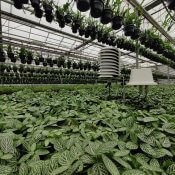Silos are for grain, not data
We make technology for agribusiness. And we’re as serious about the “agri” as we are about the “business,” because they’re inextricably linked. By providing technology to horticulture, we’re helping our customers orchestrate and balance nature, technology and the flow of information. Data-driven approaches to all aspects of growing crops, from cultivation to sustainability or pest management are crucial to the business aspect of agribusiness. Efforts to optimise resources, change strategy or adopt new technologies all have to make sense to the bottom line. They have to be a smart investment.
Speaking to our customers, partners, and the experts in our network, we see just how many factors can affect the success of an agribusiness. But it’s a sector that experiments, and discovers new links all the time. That makes sense— agriculture is, after all, science.
As such, it relies on the ability to explore information, and bring various sources of information together. As a platform, ZENSIE was built to make it easy for agribusinesses to integrate data, and augment decision-making with real-time insights straight from crops. Because it’s built with integration in mind, the agribusiness’ tech ecosystem can keep up with emerging agtech as well as evolving business needs.
From traceability to climate control, we’ve already seen a few powerful ZENSIE integrations, but it’s time to highlight yet another: augmented yield prediction. Growers tell us that forecasting is crucial: time is of the essence, and accuracy impacts business relationships, as well as the bottom line. Fresh4Cast uses artificial intelligence to improve productivity, increase margins and reduce waste for produce growers with accurate crop forecasting. Integrating data from 30MHz supercharges that yield prediction with real-time granular, crop-level insights.
Your AI’s only as good as your data
Fresh4Cast develops cutting-edge forecasting algorithms based on the data available to growers. But even the best algorithms are only as good as the data they’ve been fed. 30MHz is a source of highly relevant, accurate data, gathered remotely and continuously. By improving the quality of their data, agribusinesses can increase the impact of yield forecasting algorithms, thus helping optimise productivity and efficiency from cultivation to sales, and everywhere in between. Here’s how we’ve seen agribusinesses can benefit.
Gathering data is expensive (or, it used to be)
When it comes to data for AI, it’s about quantity as well as quality. The more data available to the algorithm, the ‘better trained’ it is. With 30MHz, wireless data capture (via sensors) is accurate and continuous. It’s also significantly less expensive than sending a team out with handheld devices to capture and monitor VWC, EC or pH. Plus, there’s no process of writing data down, transferring to a spreadsheet, paper file or local computer. Data is captured instantaneously, without the risk of human error, while human efforts can be concentrated on more value adding, and rewarding tasks. 30MHz significantly lowers the cost of data acquisition (collection and transfer), making it possible— and financially responsible— to collect more data points, and do so more frequently.
More accurate than manual collection
Let’s consider the following scenario: a grower pays an employee to measure 30 different compartments with a handheld sensor over a 9 month period. Let’s assume it takes 4 hours a day to collect a total of 60 data points, which then need time to be transferred. Let’s also assume a £10 an hour labour cost in UK. The cost is around 50p per metric. This can be prohibitively expensive for an agribusiness. But the cost of data acquisition doesn’t need to be so high. A 30MHz pointed microclimate sensor lowers the costs for data collection (and transfer and storage!) by over 98%.
Not only does measurement with the wireless sensor make data capture more frequent, accurate and consistent (a sensor can remain in one fixed location for however long is needed), agribusinesses have much more flexibility in where they monitor— even in difficult to reach places.
More powerful than data-logging
One soft fruit grower in our community deploys data loggers at each of several locations around the Kent area to better understand historical environmental conditions. While data loggers are an improvement on visual inspection or relying on weather data. But data logging is still significantly more work intensive, and less accurate or consistent than working with 30MHz tech.
At this particular customer, 4 people manage the deployment of data loggers. It takes about 2-3 hours to download data into a spreadsheet, clean the data of irrelevant data points (like measurements in transit.) That data is then manually transferred into another spreadsheet with a yield model.
It could take one individual around 2 days to complete these tasks, plus half a day transferring and augmenting data— including further potential delays in passing the information to sales. These time lags compromise data accuracy, and limit the impact of the model. Not to mention the cost of data acquisition. Data loggers are a step in making agriculture digital, but wireless sensor monitoring truly lowers the costs of acquiring data while improving precision, and the continuity of the feedback loop.

With ZENSIE, frequency of data collection actually increases savings.
Silos are for grain, not data
When data is siloed and difficult to analyse together, motivation for data-driven decision-making can suffer. One customer within our network has 5 greenhouses, each with a climate computer. Every week, an employee downloads the data from Priva into a dedicated report. This is then transferred manually into a spreadsheet. The spreadsheet generates analytics for the group for yield prediction, cultivation benchmarking and comparison purposes. Because manually transferring data is costly and time consuming, only certain metics like average temperature and daily CO2 measurements are transferred. This risks key insights falling through the cracks. And because the spreadsheet slows with each data point added, there’s little practical incentive for data contribution. With a platform like ZENSIE, data is stored in the cloud (as opposed to a local computer) and does not require manual transfer. The ZENSIE API makes it easy to connect new data sources and technologies, augmenting the power of each data set.
UK growers: let’s discuss
Besides being accurate and consistent, to truly aid in decision-making, data needs to be captured, stored and interacted with efficiently, easily— and without excessive cost. 30MHz will be joining Fresh4Cast at the London Produce Show on June 5-7. Join us for a chat, let’s discuss how quality crop data can increase value across your agribusiness, including in the essential task of yield prediction.



30MHz is typing… Our extended support team is ready to chat!
At 30MHz we think it’s important that our users can use our platform in an optimal way. At times you may have questions and you would like some help from our support team. Email and our support page filled with helpful articles were your go to’s. But we thought it was time for something extra… ...Read more
New 30MHz connect casing: How we protect your tech
To make sure your dataflow is fully protected, 30MHz introduces a new connect casing: waterproof, dust proof and even resistant to hits. This special shield will last longer and ensure a reliable dataflow from the connected sensor. What does that full protection mean? That’s what we will explain in this article. Watertight: resistant to wetness ...Read more
Digital Twin at QING
For the innovation project Digital Twin from NXTGEN Hightech, several 30MHz colleagues came together with QING to exchange ideas about digital twins within the Agrifood sector of the future. Want to know more? Check out the (Dutch) video:Read more


